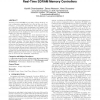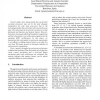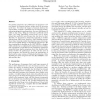DAC
2012
ACM
11 years 6 months ago
2012
ACM
Powering down SDRAMs at run-time reduces memory energy consumption significantly, but often at the cost of performance. If employed speculatively with real-time memory controller...
MICRO
2010
IEEE
13 years 2 months ago
2010
IEEE
Abstract-- We consider the problem of how to improve memory latency tolerance in massively multithreaded GPGPUs when the thread-level parallelism of an application is not sufficien...
HICSS
1995
IEEE
13 years 7 months ago
1995
IEEE
The architecture for a shared memory CPU is described. The CPU allows for parallelism down to the level of single instructions and is tolerant of memory latency. All executable in...
ICS
2000
Tsinghua U.
13 years 8 months ago
2000
Tsinghua U.
As the performance gap between the CPU and main memory continues to grow, techniques to hide memory latency are essential to deliver a high performance computer system. Prefetchin...
ISCA
1996
IEEE
13 years 8 months ago
1996
IEEE
Memory latency is an important bottleneck in system performance that cannot be adequately solved by hardware alone. Several promising software techniques have been shown to addres...
EUROMICRO
1998
IEEE
13 years 8 months ago
1998
IEEE
Several studies have demonstrated that out-of-order execution processors may not be the most adequate organization for wide issue processors due to the increasing penalties that w...
ICS
1999
Tsinghua U.
13 years 8 months ago
1999
Tsinghua U.
On modern computers, the performance of programs is often limited by memory latency rather than by processor cycle time. To reduce the impact of memory latency, the restructuring ...
ISSS
1999
IEEE
13 years 8 months ago
1999
IEEE
Partition Scheduling with Prefetching (PSP) is a memory latency hiding technique which combines the loop pipelining technique with data prefetching. In PSP, the iteration space is...
PLDI
1999
ACM
13 years 8 months ago
1999
ACM
Hardware trends have produced an increasing disparity between processor speeds and memory access times. While a variety of techniques for tolerating or reducing memory latency hav...
IPPS
2000
IEEE
13 years 8 months ago
2000
IEEE
As the speed gap between CPU and memory widens, memory hierarchy has become the primary factor limiting program performance. Until now, the principal focus of hardware and softwar...



